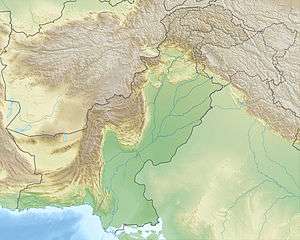Shandur Pass
Shandur Pass (Urdu: شندور) is a pass located in between the Ghizer District of [[Gilgit-Baltistan and Chitral District of Khyber Pakhtunkhwa, Pakistan. It is often called 'Roof of the World'. Shandur top is located in |Gilgit Baltistan]] and has a flat plateau and can be crossed between late April and early November. The grade is very gradual, and the area is crossed by plentiful small streams during summer.
| Shandur Pass | |
|---|---|
| شندور (Urdu) | |
 Shandur pass | |
| Elevation | 3,700 m (12,139 ft) |
| Traversed by | Gilgit–Shandur Road |
| Location | Pakistan[1] |
| Coordinates | 36°04′32″N 72°31′12″E |
 Location of Shandur Top | |
During the annual 'Shandur Polo Festival,' there are polo matches played in Shandur Polo Ground on Shandur Top, between the local teams of Ghizer, Gilgit-Baltistan and the guests teams from Chitral. Approximately seven matches are played in the three days of the festival usually held on July 7th to 9th every year. The final match is played on July 9th between Teams A of Gilgit and Chitral.
History
It was established by the ruler of Chitral Mehtar HH Shuja Ul Mulk . The polo ground was named "Mas Junali", because in the Khowar language ‘mas’ is the word for ‘moon’ and ‘junali’ is the word for ‘polo-ground’.
So Mas Junali became a source of relation between the people of Chitral District and Ghizer District. The Shandur Polo Festival opens a door step to the people of the world to enjoy their selves. Many of the people from entire world come here to watch polo match played between Chitral and Ghizer.[2] At first it was a training game for cavalry units or other Elite troops. To the warlike tribesmen who played polo with as many as 100 players to a side, it was a miniature battle. It became a Persian national game in the 6th century AD. From Persia, the game spread to Arabia, then to Tibet, China and Japan. In China, in the year 910, death of a favourite relative in a game prompted Emperor Apaochi to order beheading of all players.
Ali Sher Khan Anchan Maqpoun used to play Polo at Shandoor when Chitral was briefly occupied by Sher Ali Anchan.[3] The Princes and political agents of Chitral also enjoyed playing Polo in Shandur. Historically, polo being the king of games was played between small kingdoms, villages and rival groups of Chitral and Gilgit. From 1936 onwards polo tournaments were held annually at Shandur at the patronage of the British. The three-day Shandur Polo Festival has developed steadily in recent years into the massive celebration of mountain polo that it is today. Since 1982 the matches are being arranged by Chitral administration , levies, Chitral scout and police. GB teams participated as guests team .
References
- Shandur. Archived from the original on 2017-09-10. Retrieved 2017-08-30.
- Polo is an equestrian sport with its origin embedded in Central Asia dating back to 6th century BC
- Shandoor, Polo Ground. "Shandoor World Highest Polo Ground". www.skardu.pk. Skardu.pk. Archived from the original on 24 November 2016. Retrieved 23 November 2016.
https://www.chitraltoday.net/2019/05/31/know-some-basics-about-shandur-festival/
Books
- The Gilgit Game by John Keay (1985) ISBN 0-19-577466-3
- The Kafirs of the Hindukush (1896) Sir George Scott Robertson.
- To the Frontier (1984) Geoffrey Moorehouse, pp. 267–270. Hodder and Stoughton Ltd., Great Britain. Reprint: Sceptre edition 1988. ISBN 0-340-41725-0
- Shandur, Durand's Boundary Line Violation" (2014) by Rai Sarfaraz Shah, Ex-MNA LC Gilgit-Baltistan
External links
- https://web.archive.org/web/20180125163406/http://www.visitgilgitbaltistan.gov.pk/
- https://web.archive.org/web/20100831072645/http://gilgitbaltistan.gov.pk/
- http://www.shandur.chitralstudio.com/history/%5B%5D